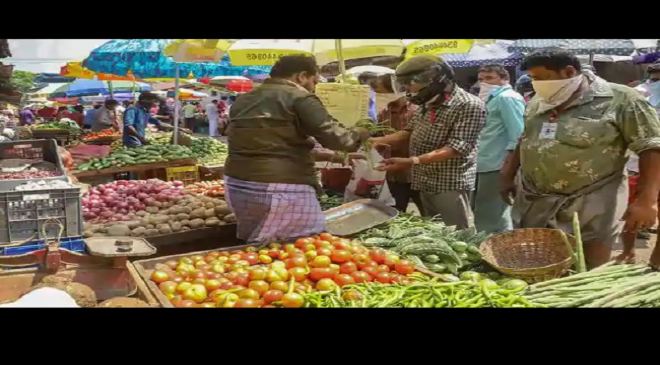Retail inflation slipped to a 10-month low of 4.85 per cent in March, primarily led by a moderation in food and fuelprices, especially lower petrol, diesel and LPG rates, showed data released by the National Statistical Office (NSO) Friday.
Read More:- TCS revenue growth crawls at 3.4% in financial year 2024
The Consumer Food Price Index-based inflation, while easing to 8.52 per cent in March from 8.66 per cent, continued to remain elevated above the 8 per cent-mark for the fifth month in a row, with rural areas persistent in showing a higher increase in food inflation than urban areas.
Data released separately showed the country’s factory output, as measured by the Index of Industrial Production (IIP), rose to a four-month high of 5.7 per cent in February from 4.1 per cent in the previous month, but was lower than the 6 per cent growth in the year-ago period.
Also Read– Flipkart opens second Andhra Pradesh grocery fulfillment centre in Vizag
Reserve Bank of India (RBI) Governor Shaktikanta Das had said last week that food price volatility remains a concern, with analysts pointing to the current heat wave as a potential cause for worry alongside the ongoing uptrend in international crude oil prices.
The latest CPI print showed that urban food inflation, while moderating to 8.35 per cent in March from 9.19 per cent in February, was sharply higher than 4.82 per cent in March 2023. Rural food inflation increased to 8.61 per cent in March from 8.27 per cent in February and 4.72 per cent in the year-ago period.
Also Read– Gold Price Falls In India: Check 24 Carat Rate In Your City On April 13
Overall, food prices softened less than expected in March, amid a seasonal uptick in prices of perishables. Economists cautioned about the impending risks from the heat wave and the likely impact on prices of perishables and other food items, which is likely to keep the RBI in a wait-and-watch mode until at least the first half of the ongoing financial year.
The headline retail inflation rate, based on Consumer Price Index (Combined), eased below 5 per cent in March after remaining above the level for four consecutive months. However, it marked the 54th month of staying above the 4 per cent mark in the 4+/- 2 per cent band of medium-term inflation target set by the RBI.
Also Read– TCS Announces Salary Hikes For Employees, Top Performers To Get Double-Digit Increments
Core inflation — non-food, non-fuel segment — remained steady at 3.5 per cent in March.
“The food products continue to be under pressure and cereals, vegetables, spices and pulses witnessed high inflation. The present heat wave poses upside risk and can increase food inflation in coming months. Comfort is in core inflation. We need to see how the recent increases in MRP by FMCG companies work out,” said Madan Sabnavis, Chief Economist, Bank of Baroda.
Inflation rate for the food and beverages segment, which carries a weight of 45.86 per cent in the CPI, eased to 7.68 per cent in March from 7.76 per cent in February. Vegetables inflation inched lower to 28.34 per cent in March from 30.25 per cent in February, while pulses inflation rate eased to 17.71 per cent from 18.90 per cent. Cereals and products inflation, however, reversed a declining trend of seven months to rise to 8.37 per cent in March from 7.60 per cent in February.
Fuel and light segment, in negative territory, slipped further to (-)3.24 per cent in March from (-)0.77 per cent in February reflecting the cut in petrol, diesel and LPG prices.
The full impact of the cut in fuel prices will also be reflected in the April inflation print, economists said. Miscellaneous inflation, which broadly indicates price change for services, inched lower to 3.50 per cent in March from 3.57 per cent in February.
Food and beverages inflation is estimated to remain above 7 per cent in April. “An intensification of the impending heat wave may worsen the seasonal uptick in prices of perishables, heightening the criticality of a favourable monsoon in 2024 to keep food inflation in check and inflationary expectations well-anchored. The ongoing uptrend in international crude oil prices could also pose a risk to the CPI inflation outlook in the near term, although the extent of the impact would depend on the pass-through to retail fuel prices, and the impact of such transmission would be relatively lesser compared to the WPI inflation given the different weights of fuel items in the CPI and the WPI baskets,” Aditi Nayar, Chief Economist, ICRA said.
Read More: Passenger vehicle wholesales up 8.4% to 42 lakh units in FY24: Industry body
Of the 22 major states/UTs, 13 registered an inflation rate above the headline inflation rate of 4.85 per cent in March, with the highest rate in Odisha (7.05 per cent), followed by Assam (6.08 per cent), Haryana (6.06 per cent), Bihar (5.71 per cent) and Telangana (5.60 per cent).
On the industrial output front, the pickup was mainly due to a low base and improved mining output. Manufacturing, which accounts for 77.6 percent of the weight of the IIP, grew by 5.0 per cent in February as against 3.6 per cent in the previous month and 5.9 per cent in the year-ago period.
Output of capital goods — an indicator of investment — grew 1.2 per cent in February, slower than 3.4 per cent in January and 11.0 per cent in the year-ago period. On the consumption front, consumer durables output, which reflects consumption demand, rose to a four-month high of 12.3 per cent in February from 11.9 per cent in January and a low base of (-)4.1 per cent in the year-ago period.
Read More: TCS Hiring 2024: IT Major Picks 10,000 Freshers From Top Engineering Colleges, Says Report
Consumer non-durables output, which reflects fast-moving consumer goods, contracted for the second consecutive month (-)3.8 per cent in February as against 12.5 per cent growth in the year-ago period.
“The trend of mixed momentum in capital-intensive sectors continues, with sectors such as manufacturing of vehicles and machinery decelerating between January and February, but accelerating in electronics, chemicals and basic metals…Growth in labour intensive sectors, such as textiles and leather goods, continues to improve on a sequential basis albeit from low levels,” said Shreya Sodhani, Regional Economist, Barclays.





































